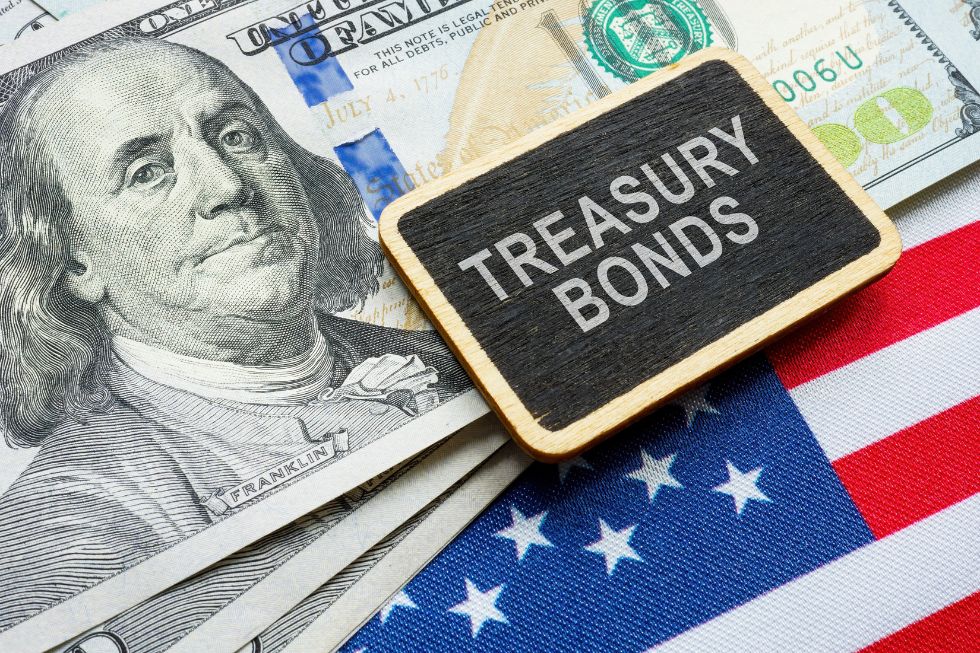In early April 2025, global markets were rocked not by a war or a banking crisis, but by a sudden escalation in trade protectionism. US President Donald Trump’s announcement of a sweeping 54% tariff on all Chinese imports triggered a sharp selloff in US Treasuries — ironically, the very assets to which investors traditionally turn for safety during uncertain times. Yields on ten-year Treasury notes surged past 4.5% for the first time since 2023. The yield on the 30-year rose above 5%.
Liquidity in future markets evaporated at a pace reminiscent of the March 2020 pandemic panic. The message was clear: Even the deepest and most systemically important market in the world is no longer immune to political volatility.
The earlier spike shocked a market accustomed to safe-haven rallies during periods of geopolitical stress. This episode underscored a growing paradox in global finance: The US Treasury market, long considered the bedrock of the international monetary system, is also a site of mounting fragility, both structurally and politically.

The bedrock of global finance — and its fault lines
US Treasuries are far more than sovereign IOUs. They serve as the global benchmark risk-free asset, the primary collateral in global repo markets and the portfolio anchor for central banks, pension funds, insurers and asset managers. Treasury yields ripple across asset classes, shaping everything from mortgage rates to equity risk premiums.
Yet as the US debt stock breached $36 trillion in 2025 (and was still rising before April), this safe asset has also become one of the most crowded and systemically consequential. Its deep entanglement with private leverage and public finance creates a dual reality: In normal times, Treasuries function seamlessly. But during periods of stress — whether pandemic, rate shock or now trade policy upheaval — cracks emerge in the market’s structural plumbing.
Liquidity as mirage
The April selloff echoed flashpoints from 2019, 2020 and 2022, each revealing persistent shortcomings in Treasury market infrastructure. Liquidity, often assumed abundant, vanished at precisely the wrong moment. Bid-ask spreads widened sharply. Depth at best prices thinned out. And key intermediaries, specifically primary dealers and leveraged hedge funds, stepped back just when their stabilizing role was most needed.
The shift in market microstructure is partly to blame. Once dominated by banks and broker-dealers, the Treasury market is now driven by principal trading firms — high-frequency, algorithmic players that provide ample liquidity in calm conditions but pull out swiftly in volatility. Their behavior exacerbates price swings, creating the illusion of depth that disappears in real stress.
As I say, liquidity in the Treasury market is like a mirage: visible in the distance, but elusive when approached.
Policy shock meets market dysfunction
April’s turmoil was not just a structural issue. The source of the volatility, the US government itself, introduced a new layer of uncertainty. Shortly after Trump declared his unilateral tariff proclamation, he made exemptions for semiconductors and consumer electronics, only to partially reverse his plan days later. The whiplash in trade policy, coupled with a broader nationalist economic agenda, rattled both US corporate planners and global investors.
At one time, the United States would manage its economic leadership with predictability. This truth was once taken for granted but now no longer holds. This erosion of credibility has direct implications for the Treasury market, especially on the demand side.
China, which once held over $1.2 trillion in Treasuries, has already trimmed its holdings to just over $750 billion. April’s developments have intensified Beijing’s debate over diversification as policymakers explore alternatives from gold and euros to increased allocations in regional projects and strategic reserves. Japan, still the largest foreign holder, is under pressure from rising domestic yields and growing scrutiny over unhedged dollar exposure.
The implications extend to the Gulf states and other reserve-rich emerging markets. Political risk is increasingly priced into their allocation decisions, with some sovereign wealth funds introducing explicit “Washington risk premiums” to US exposure models.
The return of the bond vigilantes?
For years, US fiscal dominance — the idea that fiscal needs constrain monetary freedom — was a theoretical concern. Now, markets are reacting. Bond vigilantes, once a force in the 1980s and 1990s, reemerged in April.
Instead of functioning as a haven, Treasuries became the epicenter of risk. Investors were not just reacting to tariffs — they were questioning the direction of US policy, the sustainability of its debt path and the reliability of its financial leadership.
This loss of faith triggered the mass unwinding of “basis trades” — leveraged arbitrage bets between Treasury futures and cash bonds. As volatility spiked, margin calls proliferated, leading to forced sales that intensified the selloff. In the famous words of an anonymous individual, “Everyone was heading for the same exit at once.”
Too big to fail — but not too big to flail
The Treasury market’s growing reliance on official backstops is a symptom of its systemic importance — and its fragility. During the March 2020 market seizure, the Federal Reserve intervened with over $1 trillion in emergency asset purchases. It subsequently launched the Standing Repo Facility in 2021 and revived a Treasury Buyback Program in 2024 to manage market distortions and curve pressures.
But these safety nets raise uncomfortable questions. Are markets becoming addicted to intervention? Has moral hazard crept into what should be a self-correcting system? A 2023 report by the Group of Thirty, chaired by William Dudley, former President of the Federal Reserve Bank of New York, warned that “without major structural reform, market liquidity could deteriorate further under stress, undermining monetary transmission and financial stability.”
Reform in motion — but is it enough?
Reform efforts have accelerated, albeit unevenly. The SEC’s 2023 final rule expanded central clearing requirements for Treasury cash and repo markets, aiming to reduce counterparty risk and enhance transparency. The Office of Financial Research is enhancing data granularity to better monitor intermediation flows and identify pinch points in real time.
Yet these changes come with trade-offs. Central clearing can introduce concentration risk. Margining requirements can stress nonbank liquidity providers. Reforms to capital rules, such as adjustments to the supplementary leverage ratio, have faced political resistance despite support from academics and practitioners who argue that overly tight rules hinder market functioning during stress.
There are also calls to rethink the Fed’s role more explicitly. Should it become the formal market-maker-of-last-resort for Treasuries? Should repo access be broadened to include more nonbank institutions? Should the design of Treasury auctions evolve to reflect a more fragmented and risk-sensitive buyer base?
Financial safety as political design
Petra Hielkema, Chair of the European Insurance and Occupational Pensions Authority, raised concerns last week during a closed-door presentation on behalf of EU financial regulators, signaling growing unease over the stability of US Treasuries. Once considered the bedrock of global safety, Treasuries are now at the center of mounting uncertainty. Though no immediate regulatory action is expected, her remarks reflect a sharp shift in sentiment. According to individuals familiar with the discussion, margin calls have increased among institutions exposed to long equity derivatives and fixed-for-floating swap positions, while hedge funds are scaling back on high-yield and private equity holdings amid rising volatility.
European banks appear equipped to absorb market turbulence, thanks to capital buffers accumulated over the past decade. Still, regulators are watching for deeper shifts. A representative from the European Securities and Markets Authority reportedly noted that the current disruption may open a rare window to reduce global dependence on US financial actors. This suggests the market may be broadly rethinking financial safety through a geopolitical lens.
April marks a clear inflection point not merely because of market volatility, but because the root cause lies within the US itself. The dysfunction of domestic fiscal and monetary policymaking threatens to turn Treasuries from a safe haven into a source of systemic concern. A rebalancing of global portfolios may ultimately redefine the centrality of US Treasuries in the international financial order. The US must now demonstrate that its government bonds are a more reliable safe asset than ever before.
Rebuilding the center
I believe that even as the April shock exposed moments of fragility, US Treasuries remain the most reliable cornerstone of global finance. No other asset matches their depth, liquidity and centrality in the international monetary system. Despite recent volatility, their foundational role endures.
Still, the erosion of institutional credibility cannot be ignored. Market resilience cannot rest solely on reputation or history. Preserving the Treasury market’s strength will require more than technical adjustments — it will demand political coherence, transparent rulemaking and a firm recommitment to the norms that underpin global trust in the US dollar.
The views expressed in this article are the author’s own and do not necessarily reflect Fair Observer’s editorial policy.
Support Fair Observer
We rely on your support for our independence, diversity and quality.
For more than 10 years, Fair Observer has been free, fair and independent. No billionaire owns us, no advertisers control us. We are a reader-supported nonprofit. Unlike many other publications, we keep our content free for readers regardless of where they live or whether they can afford to pay. We have no paywalls and no ads.
In the post-truth era of fake news, echo chambers and filter bubbles, we publish a plurality of perspectives from around the world. Anyone can publish with us, but everyone goes through a rigorous editorial process. So, you get fact-checked, well-reasoned content instead of noise.
We publish 3,000+ voices from 90+ countries. We also conduct education and training programs
on subjects ranging from digital media and journalism to writing and critical thinking. This
doesn’t come cheap. Servers, editors, trainers and web developers cost
money.
Please consider supporting us on a regular basis as a recurring donor or a
sustaining member.
Will you support FO’s journalism?
We rely on your support for our independence, diversity and quality.









Comment